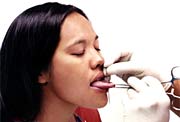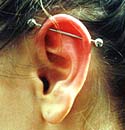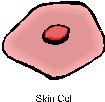Body Piercing
 Body piercing has become very popular, trendy and fashionable. Body piercing greatly varies with multiple hoops up, around, and inside the ear, or studs and rings sticking out of the tongue, eyebrow, nostril, belly-button and lips. It seems that almost every part of the body is open to piercing. While parents shout “Yuck” or “Gross” and teachers ask “Why?”, teens continue to gravitate toward body piercing. If you’re like many teens who have thought about piercing you probably see them as a personal and fashion statement, a form of body art, and a chance to establish your individuality.
Body piercing has become very popular, trendy and fashionable. Body piercing greatly varies with multiple hoops up, around, and inside the ear, or studs and rings sticking out of the tongue, eyebrow, nostril, belly-button and lips. It seems that almost every part of the body is open to piercing. While parents shout “Yuck” or “Gross” and teachers ask “Why?”, teens continue to gravitate toward body piercing. If you’re like many teens who have thought about piercing you probably see them as a personal and fashion statement, a form of body art, and a chance to establish your individuality.
Piercing may be considered cool, but there are things you need to know before you get that piercing done. Piercing are susceptible to infection during the healing period. It is extremely important to take care of your new piercing in order to promote healing and prevent infection.T hinking about piercing your tongue or eyebrow?
First, get informed. You might want to consider what the Centers for Disease Control and Prevention (CDC) have to say about it first. Scientists at the CDC are researching a possible link between tattoos and piercing and the infectious liver disease called viral hepatitis. (See our Hepatitis B section under STDs). All piercing should be done by professionals who follow health and safety guidelines that prevent the spread of these diseases. PLEASE, don’t pierce yourself or a friend. Visit the link to The Association of Professional Piercers at the end of this page for more on safety, age requirements and aftercare.
Piercing any part of your body with a non-sterile needle may put you at risk for contracting hepatitis, which is even more contagious than HIV (the virus that causes AIDS). Like HIV, hepatitis is spread through person-to-person contact with infected blood or other body fluids and as you know there is no cure. Just an FYI!
Ear Piercing
Many teenagers or young girls like to have their ears pierced. Most earrings today are available for pierced ears. If you have very small earlobes you may want to think about how an earring will look before you have it done. Ear piecing is unlikely to cause infection or to damage your ears if you have it done by someone who is trained in piecing, and you properly care for your ears afterwards. After you have your ears pierced, you must wash the area with soap daily and use isopropyl alcohol on both sides of the ear at least twice a day. It is also a good idea to use an antibiotic ointment every night for the first week. This is available over-the-counter at most drug stores or supermarkets. A triple antibiotic is preferred, but Bacitracin ointment will also work. These are available in a generic brand which works as well as the more expensive brand names.
 You should start by wearing only gold earrings first. Some people will find they are allergic to any other metal. Rotate the earrings at least twice a day to keep the holes free from scabbing. You must not removed the earrings for at least three to four weeks until the skin is healed. During the first year you should wear earrings most of the time to keep the holes from closing. Newly pieced ears will close up quickly at first if you do remove your earrings.
You should start by wearing only gold earrings first. Some people will find they are allergic to any other metal. Rotate the earrings at least twice a day to keep the holes free from scabbing. You must not removed the earrings for at least three to four weeks until the skin is healed. During the first year you should wear earrings most of the time to keep the holes from closing. Newly pieced ears will close up quickly at first if you do remove your earrings.
Do not wear dangling earrings while playing sports. They can get caught on clothing or in your hair very easily and can actually tear the earlobe.
If you pierce other parts of your ear, keep in mind that other areas besides the earlobe will take longer to heal, will be more painful, and will not close up as easily or may never close at all. (See piercing table…)
Tongue Piercing
 If you insist on getting your tongue pierced, you must use mouthwash, avoid alcohol, hot liquids and spicy foods until the area is healed. With tongue piercing healing time is approximately 3 weeks. To keep this area as clean as possible use an antiseptic mouthwash 2 to 3 times a day. Oral contact with other persons should be avoided for several weeks.
If you insist on getting your tongue pierced, you must use mouthwash, avoid alcohol, hot liquids and spicy foods until the area is healed. With tongue piercing healing time is approximately 3 weeks. To keep this area as clean as possible use an antiseptic mouthwash 2 to 3 times a day. Oral contact with other persons should be avoided for several weeks.
* UPDATE: May, 2003 – I asked my dentist about tongue piercings and problems he has seen from them. He said, tongue studs are hard, some are fairly large and they can crack, chip or fracture teeth. He has seen several patients with chipped teeth from studs. If you must have a tongue ring or stud, consult with your health care provider about taking an antibiotic just before and after piercing since the mouth is full of bacteria. If you usually take antibiotics for mitral valve prolapse before any dental work, tongue piercing is probably not a good idea for you, ask your health care provider to avoid any potential serious infection.
Ice may be used to decrease swelling. Try to focus on keeping your tongue level in your mouth to avoid biting on the jewelry as you eat. Your mouth is likely to feel uncoordinated at first, but this will pass. Gently brush your tongue and jewelry when you are healing. Once healed brush tongue and jewelry thoroughly to keep plaque away.
If you get your belly button pierced, you’ll need to deal with a long healing time – sometimes as long as five months – as well as the challenge of clothes that create friction, build up moisture, and increase the chance of infection.
 Don’t make this a do-it-yourself project. Resist the temptation to resort to your friends or to do-it-yourself piercing to get the look you want. The result can be disastrous: wrong and often unsterilized equipment producing botched and unclean piercings, and inadequately pierced openings in the wrong areas of the body. That can mean infection and the formation of scar tissue.
Don’t make this a do-it-yourself project. Resist the temptation to resort to your friends or to do-it-yourself piercing to get the look you want. The result can be disastrous: wrong and often unsterilized equipment producing botched and unclean piercings, and inadequately pierced openings in the wrong areas of the body. That can mean infection and the formation of scar tissue.
Go for quality! If you decide to go ahead with body piercing, avoid bizarre jewelry such as re-engineered paper clips or safety pins. Instead, invest in quality jewelry such as surgical stainless steel, 14K gold, or titanium. The silver coating on regular costume jewelry can wear off and increase your chance of infection.
 Piercing heals by the formation epithelial cells along the inside of the piercing to protect the body from the foreign object. These cells form a layer of skin along the inside of the piercing in about 6 to 8 weeks. Since the epithelial layer can easily be torn, do not force the jewelry to rotate without first applying warm water. The piercing may need to be soaked in warm water to allow the skin to expand. It takes six months to a year for the epithelial layer to toughen and strengthen. The entrance of the piercing will round inwards, like a donut hole.
Piercing heals by the formation epithelial cells along the inside of the piercing to protect the body from the foreign object. These cells form a layer of skin along the inside of the piercing in about 6 to 8 weeks. Since the epithelial layer can easily be torn, do not force the jewelry to rotate without first applying warm water. The piercing may need to be soaked in warm water to allow the skin to expand. It takes six months to a year for the epithelial layer to toughen and strengthen. The entrance of the piercing will round inwards, like a donut hole.
Do not remove your jewelry for any length of time while it is healing, or it will close. After the piercing has toughened, it will not close but will shrink if the jewelry is removed.
 All piercings produce a white discharge during the healing period. Symptoms of infection may include pain, swelling, inflammation (area feels warm or hot to the touch) excessive redness, and a discharge of yellow pus. If you suspect an infection contact your health care provider. DO NOT REMOVE YOUR JEWELRY. If the jewelry is removed the openings of the piercing will close and trap the infection, which can create an abscess. If you are going to get a new piercing, you must care for it properly.
All piercings produce a white discharge during the healing period. Symptoms of infection may include pain, swelling, inflammation (area feels warm or hot to the touch) excessive redness, and a discharge of yellow pus. If you suspect an infection contact your health care provider. DO NOT REMOVE YOUR JEWELRY. If the jewelry is removed the openings of the piercing will close and trap the infection, which can create an abscess. If you are going to get a new piercing, you must care for it properly.
Think about other ways you can establish your individuality. As an alternative to body piercing, consider unique jewelry, unusual clothes, wild fingernails, make-up, or washable body art and decals. Ask yourself why you want to get body piercing, then think of other things you can do to feel unique and special.
Talk over the piercing decision with your parents. A growing number of states require parental consent for piercing because these are considered invasive procedures, meaning they go through the skin into the body. Maybe they have a piercing they wish they didn’t have.
AFTERCARE
Piercing Aftercare from a professional Body Piercer, Niki Patterson:
The use of alcohol and petroleum based products (i.e. bacatracin) can cause the very infection you are trying to avoid. Petroleum products can get trapped inside the piercing and cause abscesses and infection. Alcohol and other antiseptics will break down the tissue as it is healing and slows down the healing process. Rotation of the jewelry pushes bacteria back into the piercing and breaks down the fistula that is trying to form.
If a piercing is performed properly by a trained professional, high quality jewelry is usually used and
should not need to be moved. Also, the use of mouthwash for oral piercings is quite dangerous.
A normal healthy person should not need antiseptics to care for their piercings. The body’s immune system is perfectly capable of preventing infection for a body piercing. My recommended aftercare for any piercing is
simple. Pure saline to the area to clean away lymph secretions and increase circulation 3 times a day. No soap or other antibacterial agents and no rotation of the jewelry. Piercings cared for in this manner heal in half the time with less complications.
From Niki Patterson of Tiki Tattoos and Body Piercing. Thank you Niki. You can view her work at: http://www.tikitattoos.com
Some Piercing History
PIERCING CARTILAGE OF THE EAR:
This is found in Africa, North America and South America, Indonesia, and India. It is meant to signify beauty and wealth. New types of cartilage piercing are called “DIATH” and “ROOK”.
CHEEK PIERCING: Men from Aleutian Islands used cheek piercing when they went seal hunting. By piercing their cheeks with rods, they looked like they had whiskers. Their intent was to imitate the appearances of the seal and they felt this increased their chances for a successful hunt.
EAR: This type of piercing was meant to mark life stage changes in group affiliation.
EYEBROW, and NAVEL: The Egyptians used this as a sign of royalty.
LIPS: This is also a ritual to celebrate the passage from childhood to adulthood. It also mimics facial beauty marks. This type of piercing comes from Australia, New Guinea, Africa, India, North and South America, and Indonesia.
NOSE PIERCING: The people of India view this a sign of beauty.
SEPTUM: Aborigines used bones in their pierced septums. This signified a warrior status.
TONGUE: The Maya’s performed this type of ritual when they wanted to talk to their ancestor’s spirits.
History of Piercing of Genitals
FEMALE GENITALS: There are two different kinds:
1. Labia: Truskese women pierced their labia and hung a little bell from their labia to attract a male partner.
2. Clitoris: This is a modern technique that is done to enhance female orgasms. (so they claim, the jury is still out on that one).
FEMALE NIPPLE: In the 14th century Bavarian women had diamond studded rings through their nipples and passed gold chains through them.
MALE GENITALS: The main reason for this type of piercing is increased sexual enhancement as well as initiation into adulthood. It is meant to establish male sexual identity. There are the many variations.
1. Dydoe: This is a piercing of the gland along the coronal ridge of the penis of a circumcised male. This originated in Southeast Asians and India and was felt to enhance female pleasure during intercourse.
2. Foreskin: This was used by Roman athletes to keep their attention on the games. It had a metal ring on their foreskin, which was welded shut and called a “fibula”. This prevented erections. This was also used on the foreskin. It was used also used on their slaves to prevent procreation. The Greeks also used it on their athletes. They fastened a ribbon around the foreskin and tied the end to the base of the penis. This decreased chafing and “flapping” during the games and during the Olympics, which were then played in the nude.
3. Guiche: The Samoan men pierced the flesh between their testicles and their anus. This was a ritual of puberty and was believed to stimulate the prostate gland.
4. Kandoekoe: Tribes of Borneo used round-like marble devices and implanted them under the skin on the shaft of the penis. This was meant to increase the stimulation of the vagina, and increase the girth (circumference) of the penis.
5. Palang: This method used a rod that transected the gland of the penis . This is to increase blood flow causing the gland to swell. It also was felt to make erections last longer and orgasms are more intense. In Borneo some tribal women refused to marry a male that had not had this type of piercing done. Kama Sutra recommends this for impotence.
6. Rhinoceros penis: A rigid cross bar is placed 4 inches behind the tip of the penis and projects 2 inches on either side, looking like a rhinoceros. This method of piercing is from China and Borneo.
7. Scrotum: French soldiers used this to signify passage from childhood into adulthood.
MALE NIPPLE: This signified masculine status in Roman centurions. This was seen as a sign of courage.
Beware of the risks of body piercing!
Among them are infection, allergic reactions, hepatitis B, HIV transmission, and tetanus. For example, blood poisoning, blood clots hemorrhaging, nerve damage, paralysis, staph infections and toxic shock can result from piercing the tongue, and there are more risks even after the tongue looks like it’s healed. Ask your dentist if you are concerned. Get informed before you have a tongue piercing. Many of course, heal without any complications.
Piercing leaves a hole in the tongue larger than the pinprick used to pierce an earlobe, and the constant motion of the tongue makes it more difficult for the hole to really heal. This makes it easier to contract bacterial and viral infections, as well as some diseases. Maybe now you know why your parents say “Ugh” or “Gross”. If you are 18 or older, this is a decision that you can make on your own. Just give it some thought. Many people LOVE their piercings. Read about tattoos; information that may be useful to you or a friend.
Visit Part II for a chart of Time it Takes To Heal after a Piercing Go There >
Check out BeWild.com for body jewelry and street wear.
